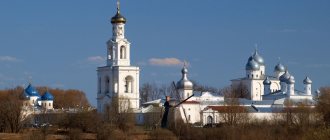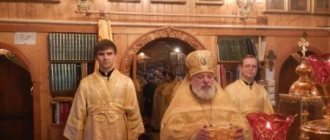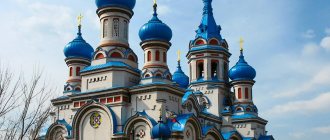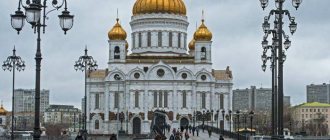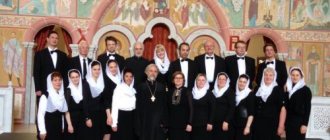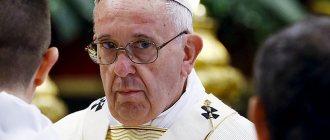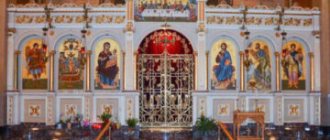I travel a lot, and not necessarily to foreign countries. Sometimes in an unfamiliar city I see a temple and begin to ask myself an almost Hamletian question: should I enter or not? Wouldn’t this be a sin if I am Orthodox and the church is Catholic, or even Protestant? In the end, I asked my confessor, and after that I made up my mind and crossed the threshold of several such temples, and even talked with the servants and priests there. It turned out that, although religious strife (for example, described in the novel “Queen Margot”) has already died down, churches do have many differences. And here's what...
Lutheran Reformation[edit | edit code]
The beginning of the Lutheran Reformation in Germany[edit | edit code]
It is believed that Lutheranism dates back to October 31, 1517, when the German Catholic monk Martin Luther published 95 theses against abuses of church power in Wittenberg, Saxony. Luther did not try to create a separate Christian denomination, he only wanted to cleanse Catholicism of the dogmatic errors that had accumulated over the centuries. Soon, in 1520, the Catholic Church declared him a heretic, and the emperor declared him a criminal (Edict of Worms 1521). However, the monk's protest unexpectedly found a response among the German princes. Luther's secular defender was the Saxon Elector Frederick III, who hid him in the Thuringian castle of Wartburg, where Luther was able to translate the Bible into German. Later, a number of Lutheran princes declared themselves at the Imperial Diet in Speer in 1529 and received the name Protestants. However, in the same year, as a result of the Marburg Dispute, contradictions were revealed within the Protestant camp between Lutherans and Calvinists. In 1530, Lutherans formulated the Augsburg Confession, which was rejected by Emperor Charles V at a meeting of the Reichstag. Then the Lutheran princes of Saxony and Hesse formed the Schmalkaldic League in 1531. The death of Martin Luther becomes a convenient reason for unleashing the Schmalkalden War, as a result of which the Lutherans are defeated. In 1548, the Augsburg Provisional Decree followed - a temporary truce with Catholics, which enshrined the main dogmas of the Catholic Church, making minor concessions to Protestants (non-obligatory celibacy for pastors and allowing communion under two types). The Augsburg Interim was followed by the Leipzig Interim, signed by Philipp Melanchthon. However, the activities of Duke Moritz made it possible to conclude the Peace of Augsburg (1555), which legalized Lutherans in the Holy Roman Empire.
Lutheran Reformation in Scandinavia and the Baltics[edit | edit code]
Meanwhile, in 1527, King Gustav Vasa begins the Lutheran reformation in Sweden, of which Finland (including Vyborg) was a part.
In 1536, King Christian III makes Lutheranism the state religion of Denmark, which at that time included Norway and Iceland.
In 1555, the Peace of Augsburg was concluded, which consolidated the division of Germany into the Lutheran North (Brandenburg, Hesse, Saxony) and the predominantly Catholic South (Bavaria).
In 1561, Lutheranism strengthened in the Baltic states when the last Landmaster of the Teutonic Order in Livonia, Gotthard Ketler, renounced Catholicism and founded the Duchy of Courland. That same year, Swedish Lutheranism took root in Estonia.
Polemics with Calvinists and the creation of the “Formula of Concord”[edit | edit code]
Melanchthon's conciliatory position (the signing of the Interim in 1548) caused a split among Lutherans between the Gnesiolutherans and the Philippists (named after Philip Melanchthon) on the issue of attitude towards the nature of the Sacrament. In 1560, for a short time, the Phillipists managed to defeat the Gnesiolutherans and spread their influence throughout Saxony. Wittenberg became the center of the Phillipists. However, in 1574 the Phillipist party was defeated. The dispute ends with the writing of the Book of Concord in 1580, which lays the foundation for confessional Lutheranism, and the period of short-lived peace is called “Lutheran orthodoxy,” but its dryness soon causes a reaction in the form of pietism.
Counter-Reformation[edit | edit code]
The Council of Trent of the Catholic Church, which ended in 1563, condemned Lutheranism and turned the Reformation into a schism.
Religious wars of the 17th century[edit | edit code]
The 17th century was marked by religious wars with Catholics, one of which led to a draw (the Thirty Years' War), and the second contributed to the consolidation of Lutheranism in Latvia (the Polish-Swedish War). In both wars, King Gustav II Adolf proved himself to be a heroic defender of Lutheranism.
Pietism and faith movements[edit | edit code]
Teaching[edit | edit code]
Pietism defines Christianity as "the Christian life"; indifference to the teachings of Christ (dogmas), emphasis on a highly moral life, personal piety, encourages separatism in the community.
Doctrine of Justification:
Reanimation of Osiander's views. Confusion of the concepts “Justification” and “Sanctification, internal renewal.” The pure doctrine of imputation is replaced by a vague idea that justification and sanctification are a single whole, the so-called “new birth”, which no longer coincides with the concept of forgiveness of sins, but means an internal transformation that is the source of a new “Christian” behavior. Those. Synergism replaces monergism, both in justification and sanctification.
Doctrine of Salvation:
Platonic tendencies colored by synergy
Doctrine of Grace:
Time of grace and opportunity for conversion may be lost before death
Doctrine of the Spirit:
The Word and Sacraments are no longer means of grace; the Spirit is given to the believer and acquired by him separately (even in spite of) from the Word and Sacraments, but through a regenerated heart.
Criterion of faith:
Area of personal experiences
The essence of faith:
Personal subjective perception of God, internal transformation
Object of Faith:
Subjective Christ
Attitude towards orthodoxy:
- rejected the failure of orthodoxy to live up to its standards
- this child of orthodoxy, but disobedient and unhappy, having rejected the problems of orthodoxy, he with a youthful ardent impulse rushed to eliminate them, but not being able to solve them, he found refuge in his subjective experiences and the Law, but not in the Sacraments and the Word
- indifference to both doctrine and heresies. A subjective, anthropocentric attitude replaces the objective perception of reality, reflected in Lutheran orthodoxy
Relation to the Sacraments:
Derogation—The Sacraments are not superior to personal discipline. The doctrine of the Sacraments is similar to that of the enthusiast. Communion and Baptism not as an act of the Triune (means of grace), but as a public confession
Relation to the Church:
Instead of the priesthood of all believers, everyone is a priest (can be his own priest); separation between pastor (general ministry) and preacher (personal preaching, often heretical)
Criterion for a true pastor:
The number of those converted to repentance from his preaching
Impact on the Church:
- methodical Bible study
- inclination towards freedom -
- as from the official teaching of the Church
- so understanding Scripture not as a source of doctrine, but as a moral code
- great emphasis on parishioners
- separatist tendencies (separation of “true” Christians from ordinary ones)
- desire for indifference and enthusiasm
History[edit | edit code]
Causes:
- Socianism (nominalism + humanism, anti-trinitarianism);
- Catholic mysticism;
- Reformed theology (Grotius and Cosseius);
- precisism (Rathman);
Diachronic development:
Early 17th century
Johann Arndt, Johann Gerhard
Mid 17th century
Theophil Grossgebauer, Heinrich Müller
Spener's Pietism (1635-1705)[edit | edit code]
1666 - pastor in Frankfurt am Main
New understanding of confirmation: from confession to vow; creates a “college of pietism,” that is, external piety
1675 - “Pia desideria” six main points:
- emphasis on intensive Bible study in private groups
- "priesthood" of all, everyone baptized is a priest
- true practice is deeds
- attitude towards others - persuasion with love
- reorganization of education, personal life becomes part of the subject “Discipline”
- Preaching - from doctrine to deeds (not the Redeemer, but the Second Moses), emphasis only on sanctification
1686 - court preacher in Dresden
1691 - received an appointment to the Church of St. Nicholas in Berlin, with the help of his father-in-law he received a post in the Consistory, where he appointed pastors and teachers
Pietism in Halle[edit | edit code]
Practical Bible study, placed in the service of edification, became central to theological work. At the same time, the method of interpretation itself has been simplified. The theologians of Halle moved away from the previous idea of the uniqueness of the verbal meaning in Scripture, and proceeded from a dual or triple meaning - literal, spiritual and mystical (Rambach).
Thus, everything that seemed tempting was explained. The study of dogma declined and lost its importance. They were content with a condensed repetition of the constructions of the era of orthodoxy, modified by Spener. They abandoned the conceptual apparatus of philosophy. Scripture was presented as a body of legalistic precepts. Many passages of Scripture are also criticized as being contrary to morality. The center of theology becomes the internal phenomenon of the soul, individual experiences.
Pietism Franke (1663-1727)[edit | edit code]
Follower of Spener.
Until 1690 is in search
1688 - contacted Spener
1689 - began teaching in Leipzig
1690 - he was expelled from the university for heresy, Spener arranges for him as a pastor in Erfurt
1691 - with the help of Spener, he gets a job as a teacher in Halle. Since that time, he has devoted his activities to ensuring the formation of institutions and ways of influencing Pietism on the world. He initiated the organization of a shelter for prostitutes and a public hospital. During the same period, Franke became associated with the Catholic Guida de Molinas movement. The Catholic Mystical Union movement modifies and, with the help of Franke, develops Spener's pietism. The desire of the Catholic orders for mission outside is accepted by Franke.
Arndt>Spener>Franke - spiritual experience of “rebirth in the Spirit”, the moment of repentance begins to prevail over the Sacraments. Franke sees fellowship with God through regeneration by the Spirit = union with God. The sacraments are not needed, they even turn away and hinder the Spirit; the most important thing is personal communication, that is, personal piety.
Characteristic features of his activities:
- a) institutions of pietism; mystical union with God without any objective means;
- b) the doctrine has fallen out of use - the most important thing is personal piety;
- c) Sacraments are not needed
Franke proclaimed the rule that every Christian should be able to point to a certain obvious conversion, which is preceded by an internal crisis caused by the preaching of the Law (the struggle of repentance). Being in this state, a person is led to the decision to break with the world and start a new life, after which faith is granted. By this faith the forgiveness of sins is received. Moreover, everything natural is viewed as something sinful in itself. Dancing, games, theater, etc. are sinful.
Pietism of Arnold (1666-1714)[edit | edit code]
1685 - In Wittenberg, Arnold is very concerned about the doctrine of the Sacraments, are they true?
1697 - Becomes professor of history at Giessen. He wrote the work “The Unflattering History of the Heretics of the Church,” in which he expresses his view on the history of Christianity, according to which the true teaching existed only outside the official Church, among heretics of different times and peoples. Translated from Latin into German “Guida Spirituale”.
Through Franke and Arnold, mystical Catholicism finally merged with Pietism. This scheme determines the general development of pietism - from moderation to expression.
The influence of the theosophical philosophy of J. Boehme is traced. The Jewish view of the 1000-year Kingdom is accepted, and it is understood as liberation from the state and the Church. The orthodox doctrine of reconciliation is criticized. According to pietistic radicals, satisfaction is contrary to the love of God, which, of course, covers sin and transforms the heart. For them, everything in Christianity is immanent, subjective. Like Boehme, they adhere to the view of restoring everything.
Pietism in Württemberg A. Bengel (1687-1752)[edit | edit code]
The direction is strictly ecclesiastical in nature in matters of basic dogma. Württemberg Pietism adheres to orthodox theology, but the prevailing views of Pietism and the struggle against rationalism of the time left an indelible mark on it.
1713 - he is a professor and pastor in Denkendorf
1734 - publishes the New Testament (20 manuscripts + other versions). The father of textual criticism, he began to divide manuscripts into families.
1740 - interpretation of the Apocalypse
1741 - publication of "Orado Temparum"
1742 - “Gnomon Novi Testamenti” main features:
- 1. add nothing to Scripture
- 2. take everything from Scripture
- 3. leave nothing hidden in Scripture:
- a) reverence for Scripture
- b) uses specific, hitherto unknown grammatical rules
- c) approaches the study of Scripture, excluding history, theology, and traditions; declaring that this is the scientific method of analyzing Scripture.
He is distinguished by keen observation and deep elaboration of text details. His ideal is concrete consideration without any formalism. Uses prophetic interpretation of history.
Then he takes chiliastic positions and calculates the specific date of the end of the world (1836)
Further confrontation between Lutherans and Reformed in Germany[edit | edit code]
In 1640, Frederick William I became Elector of Brandenburg. The son of the Calvinist princess Elizabeth Charlotte of the Palatinate, he was educated in the Netherlands. Having become ruler, Frederick William encouraged immigration to the lands under his control of the Huguenots, whose persecution resumed in France in the 17th century (as a result, by the beginning of the 18th century they made up a quarter of the population of Berlin). The Elector also tried to legislatively reconcile the Lutherans with the Reformed, for which he also issued the Edict of Tolerance (de: Toleranzedikt (Brandenburg)). On the other hand, persecution of zealous Lutherans began, for example, the famous hymnographer Paul Gerhardt was removed from his post in the capital's church and sent to the provinces.
Frederick William's successors continued his course, and in 1817, King Frederick William III of Prussia finally united the Reformed and Lutherans within the framework of the Prussian Union, which caused the formation of the Old Lutheran movement and their emigration from Germany, including to North America and Russia.
In Germany itself, the union gradually spread to territories that were again included in the German Empire. The modern Evangelical Church of Germany, the largest association of Protestant denominations in Germany, is a unionist association of Lutherans and Reformed people.
Differences between Catholicism and Lutheranism.
| Signs | Catholicism | Lutheranism |
| Justification by Faith | In Catholicism, a sinful person is justified before God by “good works” with the help of the church. The church acted as a mediator between God and the laity, assessing the degree of godly “good deeds” and, accordingly, the degree of atonement for sin. | In Lutheranism, every Christian achieves the salvation of his soul solely through the faith given to him in the atoning sacrifice of Jesus Christ. |
| Direct control over faith and conscience . | Claims of the clergy to the right of mediator between people and God. | Communication with the Lord is possible for every pure-spirited Christian. |
A radical transformation of the church. The idea of abolishing the guardianship of the papal curia had far-reaching consequences: the preconditions were created for the political unification of Germany, the outflow of huge sums of money to Rome was stopped, a third of church holidays were abolished, and entrepreneurship was stimulated.
State concept.
The doctrine of the "two kingdoms". The distinction between the religious and secular spheres (“service” and “personality”). He rejected the thesis about the primacy of spiritual power over secular power.
| Religious authority | Secular power |
| The religious organization of society is completely autonomous. Freedom of conscience, faith, and the inner world of man are the sphere of exclusively spiritual power. The invasion of secular power into religious life is justly met with resistance through the power of speech and suffering for the faith. The only judge and avenger is God. | Secular power is involved in economics, politics, education, and culture. Officials (“personalities”) are obliged to follow the interests of their subjects, guided by ethical principles and norms of natural law. Subjects have no right to resist authority. Disobedience to authority is a sin more serious than murder. |
Autonomy of civil law (positive law). It was exempt from the tutelage of canon law, but since cannot take into account the whole variety of social conflicts, it should not be elevated to an absolute. Intelligence
-
“teacher of the law”,
therefore plays an important role in politics.
Thomas Munzer (c. 1490 - 1525) - ideologist of the radical movement - plebeian [3], a contemporary and initially a follower of Luther.
The Reformation according to Münzer is the transformation of the world on the basis of the primacy of common interests. Having supported Luther's thesis of "justification by faith", Münzer " faith
“associated with active actions against the oppressors (he considered them atheists).
Only working people are able to understand God, because... their interests completely coincide with the interests of society. The triumph of common interests over private ones
is the basis of social transformation. The coming “earthly paradise” is a society where there are no private interests and cannot be.
Münzer paid attention to immediate goals , setting them out in the radical manifesto “Article Letter
": the unification of artisans and ploughmen" (working people) into a "Christian union and brotherhood", the elimination of masters, incl.
by violent means, establishing a just society. In Münzer's views there were the beginnings of republican and socialist ideas
: the determination of state policy by the people and control over it by the people. Such radicalism of Münzer alienated moderate reformers and contributed to the strengthening of conservative elements in the burgher camp of the Reformation.
John Calvin (1509 – 1564) is the founder of the Calvinist movement in Protestantism.
Main works: “Instructions in the Christian Faith.”
The unconditional authority of Holy Scripture. God has expressed his will once and for all, and people must coordinate their lives with the letter of this law. The opinion of the fathers and teachers of the church, papal bulls are significant if they correspond to the direct meaning of Holy Scripture. The belief in the omnipotence of reason is rejected.
The doctrine of predestination complemented Luther's doctrine of justification (salvation) by faith. A person is saved by faith, which descends upon him as a result of God’s grace; man cannot be saved without the help of God. There is no free will: God initially wrote some in the book of life, and others in the book of death. Only those “chosen” by God can be a true believer, but a person, not knowing which book he is in, must strive to be among the “elect.”
Protestant Ethic . In political terms, divine predestination meant a moral (religious) obligation to devote oneself to business, to one’s profession, to be a hardworking, enterprising and zealous owner. This was how the foundations of ethics were laid, which, combined with individualism, became a feature of Western social life.
Reform of the structure of the church.
The radical reform of the church abolished the clergy in its traditional form. Church communities began to be headed by lay elders and preachers who received appropriate training, but did not have rank. They formed a consistory that governed the religious life of the community.
State concept . The independence of the religious community is the basis for the development of republican programs. The two powers are united into a single whole under the dominance of the church. The state was established by God and is necessary to man like air. Protesting against power, even the most cruel, is insolence against God's will. Only when the demands of power contradict the Holy Scriptures can subjects resist. Preference is given to the republic. The worst political regime is democracy (dominance of the mob), the best is aristocracy or oligarchy (“God can “elect” only a few - aristocrats of faith”).
2. Legal views of K. Marx and F. Engels.
1) Karl Marx (1818 - 1883) and Friedrich Engels (1820 - 1895) are the founders of “scientific socialism”, or Marxism. OP : “Manifesto of the Communist Party” (1848, Marx), “Critique of Hegel’s Philosophy of Law” (Marx), “The Origin of the Family, Private Property and the State” (Engels), “Capital” (Marx), “Anti-Dühring” (Engels ). Marx initially believed in his genius and lived at the expense of Engels.
2) Marxism is a product of the long intellectual development of Europe. Its founders sought to synthesize the achievements of different schools of philosophical, economic, socio-political thought. IN AND. Lenin spoke of three sources of Marxism: German classical philosophy with Hegel's dialectics and Feuerbach's materialism, English classical political economy (Smith and Ricardo) and utopian socialism. There were other influences - the political experience of revolutionary movements, starting with the French Revolution, advances in the field of natural sciences and social research. The basis of Marxism is a materialist interpretation of history, historical materialism. Marxism appeared as a reaction to capitalism; it could not have arisen earlier, because... there was no social support.
3M. and E. tried to penetrate the mystery of property inequality and social contradictions. They believed that they were based on the production system, the relationships that people enter into during the production process. The type of these relations is objectively determined by the level of development of the productive forces, i.e. means of production (natural resources and tools). Production relations determine the entire structure of society and its development. In relation to production, all other aspects of social life act as a derivative, as a consequence, as a superstructure over the economic base. (This idea is set out in the “German Ideology”, “Manifesto of the Communist Party”, and carefully developed in “Capital”)
4) Economic mechanism of historical development: productive forces develop continuously and periodically come into conflict with established production relations and outgrow their framework. Then there is a breakdown of outdated relationships, a new method of production arises. will exist as long as the correspondence between the level of development of software and software is maintained. Those. source mechanism Development is a change in production methods.
5) The concept of class interests, the class approach to all phenomena of social life, the idea of history and the current state as a continuous series of class contradictions and conflicts is the second most important contribution of Marxism to the methodology of political thought and no less important than swearing. interpretation of history. Ideas about the paths of development stemming from historical mathematics and the class approach were first set forth in the Manifesto of the Communist Party. A ghost is haunting Europe, the ghost of communism. The history of all societies is the history of class struggle. The fall of the bourgeoisie and the victory of the proletariat are inevitable. “Proletarians have nothing to lose except their chains, but they will gain the whole world. Workers of all countries, unite!”
6) A change in the social system occurs through revolution. Her primary task is to gain power. Revolutions usually take violent forms. The proletariat establishes its rule through the violent overthrow of the bourgeoisie. But the proletariat must use all the possibilities for carrying out a revolution peacefully. M. and E. imagined that the social. the revolution must win simultaneously in all major capitalist countries. The goal of the revolution is to eliminate the exploitation of man by man, to build a classless society that has obsolete private property, to increase production, culture and the well-being of the masses. The creation of a communist society is a long process. It requires a transitional period of “revolutionary transformation” of capitalism. society into a communist one.
7) The origin of the state in the “German Ideology” is associated with the social division of labor, the emergence of private property and antagonistic classes. E. developed this position in “The Origin...”. He believed that the state includes the management of general affairs and class power. From the uniqueness of the Marxist understanding of the state also follows the concept of its withering away, which seems absurd to those who identify the state with public power. But after dying out, arbitrariness will not reign. Management will remain, but it will lose its class character and return to its original essence. M. and E. are reproached for absolutizing ecology. and class factors in determining the character and fate of the state, while neglecting the cultural, national-historical features of the formation of the state and, in general, historical development in different countries.
8) The term “dictatorship of the proletariat” was first used by Marx in “The Class Struggle in France”. It is not in the Manifesto. Neither M. nor E. gave a definition of the dictatorship of the proletariat, and subsequently two interpretations of it appeared. IN AND. Lenin proceeded from the fact that any dictatorship is a power based on violence, and in Russian conditions he justified restrictions on human rights and the rejection of universal and equal suffrage for the sake of ensuring the power of workers (a republic of councils). Kautsky understood the dictatorship of the proletariat not as a special form of power not based on law, but as the transformation of workers into the ruling class, i.e. as the class essence of the state emerging after the victory of the socialist. revolution. The coming of the proletariat to power was carried out peacefully, through universal suffrage. right. Hence the dictatorship of the proletariat is the triumph of democracy. Her state The form can only be a parliamentary republic.
According to Marx, the dictatorship of the proletariat did not mean the power of one class imposed by force on the rest of society. M. characterized it as unity with the revolutionized elements of the petty bourgeoisie and peasantry.
9) The state is an organization for systematic violence of one class over another, it is any organized systematic violence against people in general. (Zhukov).
10) M. and E. have the same methodological approach to law as to the state: it cannot be understood from itself, is rooted in the material conditions of life and has a class character. Law is the will of the ruling class elevated to law, conditioned by the economy of its life. Law and government are a tool for supporting violence. (Zhukov)
M., considering law as a form of production relations, he emphasizes that law is not able to subjugate primary production relations. Assessing traditional ideas about law as relations of equality, M. writes that under the bourgeois system, law is a fiction. Equality is formal. There is no real freedom. The lack of private property among the poor deprives them of freedom and equality.
A comment. 1) The classification into utopian and scientific socialism is very doubtful. Every human science is partly utopian, the question is how much. 2) Capitalism is changing by the end of the 19th century. The middle class is increasing and the proletariat is decreasing. And Marx thought that the proletariat would only be poor, but everything happened the other way around. Marx thought that bourgeois democracy would lead to an escalation of conflicts, but the opposite happened. Therefore, if Marx and Engels had been born 30 years later, they would not have written this, since it would simply be pointless to do so. 3) Based on the teachings of Marx, many directions were created (Freud-Marxism, Trotskyism). Major works: "Manifesto of the Communist Party", "Anti-Dühring" and "Capital". But these are all just the basics; they haven’t created a whole system. 4) Idealistic understanding of history - the basis of human history is a change in human consciousness (Saint-Simon, Comte). Which is more correct, mat. Understanding or idealistic? Answer: there is no point in arguing, it is a matter of taste. 5) The dictatorship of the proletariat is, first of all, a transitional state between capitalism and socialism. The tasks of the dictatorship of the proletariat are: a) to destroy the oppressive class; b) destroy the army and police; c) build a socialist economy (!!!). 6) The difference between bourgeois. And a flight. Revolution. The Bourgeois Revolution completes the transition from feudalism to capitalism; this is a natural act of history. And the proletarian revolution is a transition from capitalism to socialism; it is unnatural, since it has no social basis.
Ticket number 11.
1. Political views of T. Mora.
Thomas More (1478 – 1535) – representative of socialist thought (sometimes utopian socialism). He made a career as a lawyer. The founder of European socialism, gives a draft social structure.
The main work "Utopia".
Overseas missions[edit | edit code]
In the 18th century, preacher Bartholomew Ziegenbalg began Lutheran preaching in India. A little later, Heinrich Muhlenberg went to North America and in 1748 organized the Pennsylvania Ministerium, the first Lutheran congregation in the New World.
In the 19th century, German immigrants actively created communities in Missouri (1847) and Wisconsin (1850), as well as in Africa (Namibia)
Lutheran churches in South Africa[edit | edit code]
In South Africa, the emergence of Lutheran churches is associated with the missionary activities of German and Scandinavian pastors, which dates back to 1737, when G. Schmidt, a representative of the Church of the Moravian Brethren, arrived here. But the truly active spread of Lutheranism began only in the 19th century, when missionary societies representing the Lutheran churches of Germany, Switzerland, Denmark and Scandinavia began their work here.
In addition to missionary activity among Africans and “coloreds,” another important source of the formation of Lutheran communities was the emigration to Southern Africa of people from Northern Germany and Scandinavia. The organizational development of Lutheran missions occurs at the end of the 19th - first third of the 20th centuries. At this time, Lutheran conferences and synods emerged based on regional and ethnic principles, and membership in a specific missionary organization. By the middle of the 20th century. there were already 13 Lutheran and Moravian synods, which were already independent churches. In 1975, based on the unification of four autonomous Lutheran churches, the Evangelical Lutheran Church in South Africa (ELCSA) was formed, which to this day remains the largest of the Lutheran churches in South Africa. In terms of its ethnoracial composition, it is primarily a church of Africans (87% of parishioners according to the 2001 census).
The religious communities created in the past by Lutheran missionaries were mostly organized along racial lines. Officially, Lutherans openly condemned the apartheid policy back in 1963, but Lutheran churches, formed from the parishes of European emigrants, remain to this day predominantly white in composition. In some of them, services continue to be held in German. The church organization of African and white Lutheran churches also has its own specific features. The former are characterized by a strict hierarchical structure, while in predominantly white churches, real governance is concentrated in the hands of the religious congregations themselves, with the synod providing general coordination of their activities. In recent years, there has been a significant outflow of parishioners from Lutheran churches. From 2003 to 2005 ELKSA lost 23.4% of its parishioners and their number decreased to 589 thousand members. (2005). The second largest among Lutherans is the Moravian Church (Moravian Brethren) with a congregation of just over 100 thousand members. (2005). Other Lutheran churches in South Africa number between 2-4 thousand members. up to 20-40 thousand people
Orthodox
Church of the Eastern Rite.
- The Church is divided into local churches, each of which has its own head (patriarch).
- Priests (these are also only men) can create families. Their task is to be an example for parishioners. An Orthodox priest can be distinguished by his beard (although these days it will not necessarily be long).
- Any manifestations of homosexuality (as well as various sexual experiments in a bisexual couple) are considered a sin.
- There are also monasteries (the so-called black clergy - there is also a white one, these are priests serving in churches who can marry).
- The baptism ceremony can be performed from birth.
- Crossing: from left to right.
- The sacrament of confession is similar to the Catholic one.
- They venerate the relics of saints, icons, pray to saints, martyrs, and righteous people.
- They believe in heaven and hell.
It is interesting that in Russia Orthodoxy is also practiced by the so-called Old Believers (the so-called Old Orthodox). Their trend arose as a result of a schism in the Russian church (1650-60), during which Christians, who had become such during the baptism of Rus', did not want to put up with some of the reforms of Patriarch Nikon (and, in particular, changes in the service of God).
Due to numerous requests from readers, we have prepared an “Orthodox Calendar” application for smartphones. Every morning you will receive information about the current day: holidays, fasts, days of remembrance, prayers, parables. Download for free: Orthodox Calendar 2022 (available on Android)
Their churches have their own rules - for example, unlike the Orthodox, Old Believers cross themselves with only two fingers. How does the “official” church treat them? Father will give the answer:
Will they let you into such a church? Old Believers are very picky about strangers. Somewhere they refuse everyone indiscriminately, and somewhere they only let you in to look, and even then only if the man has a beard and the woman is wearing a long dress with sleeves (these people do not respect open knees and armpits, as well as women’s shorts and pants).

